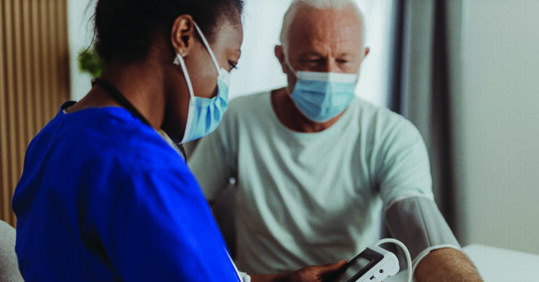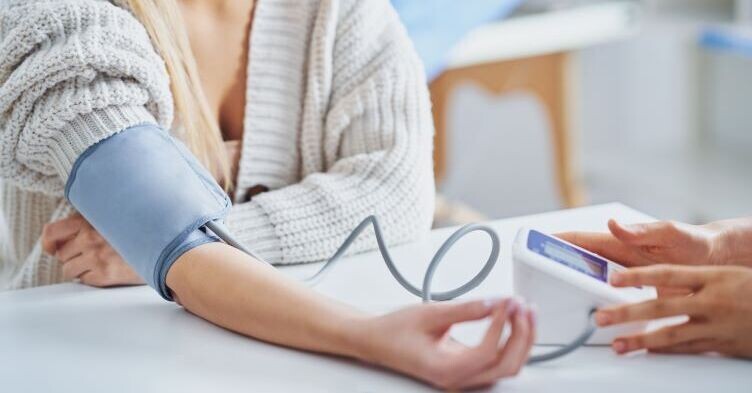Ten top tips: Hypertension diagnosis and management

Cardiovascular specialist nurses Joanne Haws and Michaela Nuttall discuss best practice in the diagnosis and management of hypertension in primary care.
Diagnosing hypertension and controlling blood pressure (BP) is a key area of disease prevention in primary care. Approaches to detecting raised BP are evolving and new monitoring requirements in primary care mean it is important to keep up with evidence-based practice and guidelines. Here are our top tips for ensuring optimal care for patients with hypertension in the community.
1: Support opportunistic screening
The first step in managing hypertension is looking for it. Undiagnosed hypertension leads to outcomes such as stroke, heart failure and heart attack. Nurses should look for opportunities to check BP at most if not all clinic appointments (unless checked recently and found to be normal). While it can often feel that we are too busy to check everyone’s BP, it is always worthwhile.
Blood Pressure UK, which runs the campaign ‘Know Your Numbers’, has produced lots of resources on what nurses require to deliver opportunistic screening.1
2: Get the technique right
Measurement of BP is a common and important clinical assessment, but is often done incorrectly. Given the pressures healthcare workers are facing, it’s essential to ensure it is done properly to avoid the need for repeat readings and adverse clinical consequences. The environment should be standardised wherever possible, whether in a clinical setting or in the home. The British and Irish Hypertension Society (BIHS) has a range of resources that offer a valuable reminder of the correct technique, including monitor choice, cuff size, patient positioning and measurement protocol.2
BP will usually be measured in the seated position, but it is important to check for any postural drop in patients with symptoms of falls or dizziness. To do this, measure the BP while the patient is seated and again after they have been standing for at least a minute. If the systolic BP (SBP) reading falls by more than 20mmHg, use the standing reading for diagnosis and management.3
3: Explain the risks of high BP
The first step in communicating risk of high BP is to let people know their numbers. All too often, patients says, ‘oh, the nurse/doctor said it was a bit high’. Explain that raised BP on a single occasion does not mean a diagnosis. Then explain the numbers, the potential impact of high BP and the next steps towards diagnosis. While clinicians may assume they have explained this well, there is often miscommunication in healthcare, including what patients recall. Along with the Blood Pressure UK resources, a useful digital tool is Share the Pressure,4 which can be used in the clinical setting or directly by patients. The NHS Heart Age Test, an online risk calculator, can help people understand the impact of raised BP on their heart, and how reducing it can help.5
Related Article: Diagnosis Connect service will link people to advice from charities
4: Make sure raised BP is confirmed
A reading of 140/90mmHg is the threshold for concern, and the patient will enter the diagnostic pathway for hypertension. A reading of ≥180/120mmHg should prompt urgent, same-day review by the GP practice (see tip 10). A hypertension diagnosis will usually happen in primary care, mostly in general practice, although pilot programmes are taking place in community pharmacies across England.6
Ambulatory BP monitoring (ABPM) remains the gold standard for diagnosis but home BP monitoring (HBPM) should be initiated if ABPM is unsuitable or the patient is unable to tolerate it. For example, anticoagulated patients may be at an increased risk of bruising with ABPM; the BIHS recommends they be advised to discontinue it if this happens. Readings that are required to confirm a diagnosis are outlined in Table 1.3
Table 1: ABPM/HBPM readings required to confirm the diagnosis of hypertension
Method
Requirements
Diagnosis
ABPM
At least two measurements per hour during the person’s usual waking hours, average of at least 14 measurements
Average daytime reading
HBPM
Two consecutive seated measurements, at least one minute apart, blood pressure is recorded twice a day for at least four days and preferably for a week
Measurements on the first day are discarded – average value of all remaining is used
Note that this can be a point where patients ‘slip through the net’ and the opportunity for a diagnosis is missed. The Primary Care Network Directed Enhanced Service is incentivising practices to follow up raised BP readings through the Investment and Impact Fund.7
5: Record the diagnosis accurately
Once the clinic reading and daytime average readings from ABPM/HBPM are available, a diagnosis of hypertension can be made or excluded, according to the classification described in Table 2.8
Table 2: Stages of hypertension
Stage
Clinic BP
ABPM/HBPM reading
Stage 1 hypertension
≥140/90mmHg
≥135/85mmHg
Stage 2 hypertension
≥160/100mmHg
≥150/95mmHg
Severe hypertension
≥180/110mmHg
n/a
It’s essential that both clinic and home readings are taken into account and that the information is entered in the patient’s clinical record. The appropriate diagnostic code should place the patient on the practice hypertension register to ensure full assessment of cardiovascular (CVD) risk, monitoring for target organ damage, appropriate interventions and annual review.
6: Involve patients in their management plan
Patients should be involved in deciding how to manage their condition. All patients should be offered information on lifestyle changes to reduce BP and given details of patient organisations such as Blood Pressure UK that can support them.1
At stage 1 hypertension, consider two questions: has the raised BP caused a problem yet, and is it likely to.
The first question is answered through tests to assess for target organ damage, including blood and urine tests to check kidney function and diabetes status, fundoscopy to assess for retinal damage and a 12-lead ECG to assess for left ventricular hypertrophy. The second question requires a full assessment of CVD risk using a recognised tool such as QRISK®3.9 If there are signs of target organ damage or an estimated CVD risk of 10% or more, discuss antihypertensive medication with the patient. Always consider age, as pharmacological intervention would not usually be indicated in newly diagnosed stage 1 hypertension in the over-80s.3 At stage 2 and severe hypertension, all patients should be offered medication.
7: Lifestyle changes really can lower BP
While there are non-modifiable risk factors such as ethnicity and genetics, lifestyle can make a real difference. Smoking, excessive alcohol consumption, excess dietary salt, unhealthy diet, obesity and physical inactivity are all modifiable risk factors and addressing them can sometimes be more effective than medication. Examples of reported benefits are shown in Table 3.
Related Article: CVD prevention must be national health priority, says report
Table 3: Impact of lifestyle on blood pressure8
Modification
Recommendation
Potential SBP reduction
Reduce weight
Maintain normal body weight (BMI of 18.5-24.9kg/m2)
3-20mmHg
Adopt DASH diet
Rich in fruit, vegetables and low-fat dairy; reduced saturated and total fat content
8-14mmHg
Reduce dietary sodium
<100 mmol (2.4g)/day
2-8mmHg
Increase physical activity
Aerobic activity >30 min/day most days of the week
4-9mmHg
Reduce to moderate alcohol consumption
Men: ≤2 drinks/day
Women: ≤1 drink/day2-4mmHg
While lifestyle changes aren’t easy, behavioural techniques such as motivational interviewing can increase the chances of success.10 Remember, maintaining changes can be difficult and slipping back into old ways can see BP rise again, so monitoring should continue.
8: Make the most of medications
Effective use of the ‘ACD’ algorithm – where A is an ACE inhibitor or angiotensin receptor blocker, C a calcium channel blocker and D a thiazide-like diuretic – will successfully control BP in most cases but it may take time.11 The physiological mechanisms driving high BP may need different pharmacological approaches, and many people will require combination therapy.
Target levels vary according to age and comorbidities such as chronic kidney disease or previous stroke. For most people, the target clinic BP will be <140/90mmHg or <150/90 for over-80s.3 Remember, those with postural hypotension, over-80s and patients with type 2 diabetes should have their BP measured while standing, and be treated to target based on their standing BP.3
It’s worth making patients aware that it may take some time to get the right combination of medication, and adherence is vital. Shared decision making using validated tools and resources can support this process and empower patients to take control of their condition.3
9: If target is not achieved, look at further options
If BP is not controlled through a combination of three ACD medications in an adherent patient, treatment-resistant hypertension should be assumed.3 It is then sensible to repeat ABPM or HBPM to confirm the readings and rule out a ‘white coat’ effect.
The first-line fourth agent is low-dose spironolactone in a person with a potassium level of ≤4.5 mmol/L, or an α- or β-blocker if their potassium level is >4.5mmol/L.3 If BP remains uncontrolled on optimal tolerated therapy with four different agents, refer for specialist assessment.
Related Article: Prescribing in England to be led by a single national formulary
10: Know when to review and refer
For adults under 40 with a confirmed diagnosis, consider routine referral for specialist investigation.3 Always review newly detected severe hypertension (≥180/120mmHg), with consideration of same-day intervention.3 Severe hypertension with signs of retinal haemorrhage or papilloedema, chest pain, new-onset confusion, signs of heart failure or acute kidney injury, or suspected phaeochromocytoma should prompt referral for same-day assessment and treatment.3
Michaela Nuttall and Joanne Haws are cardiovascular specialist nurses and members of the Nurses and Allied Health Professionals working party of the British and Irish Hypertension Society. They also run the not-for-profit organisation Learn with Nurses
References
- Blood Pressure UK. Link
- British and Irish Hypertension Society. Blood pressure measurement. Edinburgh: BIHS, 2007. Link
- NICE. Hypertension in adults: diagnosis and management. London: NICE, 2019. Link
- Share the Pressure. Link
- NHS Health Check. Heart age test. Link
- NHS England. Advanced service specification: NHS community pharmacy hypertension case finding advanced service. London: NHSE, 2021. Link
- NHS England. Network contract directed enhance service: contract specification 2022/23 – PCN requirements and entitlements. London: NHSE, 2022. Link
- Chobanian A et al. The seventh report of the Joint National Committee on prevention, evaluation and treatment of high blood pressure. JAMA 2003;289:2560-2572. Link
- Hippisley-Cox J et al. Development and validation of QRISK3 risk prediction algorithms to estimate future risk of cardiovascular disease: prospective cohort study. BMJ 2017; 357:j2099. Link
- NICE. CKS. Hypertension: Risk factors. London: NICE, 2022. Link
- NICE. Hypertension in adults: diagnosis and management. Visual summary. London: NICE, 2019. Link

See how our symptom tool can help you make better sense of patient presentations
Click here to search a symptom




